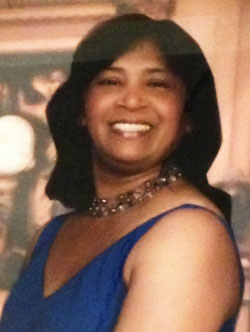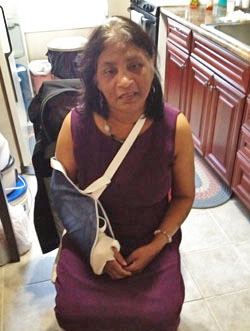Shakeela Subramany
by the Subramany Family
The death of a loved one, whether it be a parent, child, sibling, general relative, or friend is always tragic. However, my brother, father, and I would contend that the death of a loved one suffering from the debilitating and disabling disorder known as progressive supranuclear palsy (PSP) is one in which no single word can fully describe. Over the last five years, we slowly watched as our mother and wife, Shakeela, a woman who was characterized as selfless, independent, expressive, and “the life of the party,” became a prisoner of her own body. Before the onset of PSP, Shakeela spent the majority of her career in the field of magazine publishing and advertising, working for magazines such as Shape, Lucky, Vanity Fair and Playboy. As time elapsed however, and her PSP progressed and worsened, Shakeela was unable to read, recognize, and physically see the magazines that she spent much of her life improving. Sadly, Shakeela Subramany passed away on January 5, 2014.
 Our journey with PSP began one day, approximately five years ago, as our mother expressed some concern over a lingering and consistent dizziness. After a routine visit to one of her neurologists, Shakeela was diagnosed with an inner ear infection, a condition that not only explained her dizziness, but a condition for which medication and time would help to alleviate such symptoms. However, as the days and weeks passed, Shakeela continued to report this “dizziness” and soon expressed an inability to read words off of a sheet of paper, whether it was from her monthly New York Times bestseller or her favorite gospel hymn book. Soon, our mother’s primary care physician recommended outpatient vestibular therapy from the Rusk Rehabilitation Unit at NYU’s Medical Center, in the hopes of strengthening her eye muscles and preventing further decline. During her therapy, we were referred to a neuro-ophthalmologist affiliated with NYU’s Medical Center. At her appointment, it was clear that our mother was unable to move her eyes vertically, a condition which we learned was known as vertical gaze palsy. After this appointment, our mother was admitted to NYU Langone Medical Center for further testing, in the hopes of identifying and diagnosing her condition. After a five day stay, in which countless procedures and examinations were performed, Shakeela received a preliminary diagnosis of progressive supranuclear palsy; however, the neurologists on her case were hesitant to confirm the diagnosis until more testing was conducted. During her stay, our mother was levodopa responsive (Parkinson’s medication), but that response was short-lived.
Our journey with PSP began one day, approximately five years ago, as our mother expressed some concern over a lingering and consistent dizziness. After a routine visit to one of her neurologists, Shakeela was diagnosed with an inner ear infection, a condition that not only explained her dizziness, but a condition for which medication and time would help to alleviate such symptoms. However, as the days and weeks passed, Shakeela continued to report this “dizziness” and soon expressed an inability to read words off of a sheet of paper, whether it was from her monthly New York Times bestseller or her favorite gospel hymn book. Soon, our mother’s primary care physician recommended outpatient vestibular therapy from the Rusk Rehabilitation Unit at NYU’s Medical Center, in the hopes of strengthening her eye muscles and preventing further decline. During her therapy, we were referred to a neuro-ophthalmologist affiliated with NYU’s Medical Center. At her appointment, it was clear that our mother was unable to move her eyes vertically, a condition which we learned was known as vertical gaze palsy. After this appointment, our mother was admitted to NYU Langone Medical Center for further testing, in the hopes of identifying and diagnosing her condition. After a five day stay, in which countless procedures and examinations were performed, Shakeela received a preliminary diagnosis of progressive supranuclear palsy; however, the neurologists on her case were hesitant to confirm the diagnosis until more testing was conducted. During her stay, our mother was levodopa responsive (Parkinson’s medication), but that response was short-lived.
Shortly after our mother’s first hospital stay ended, we were referred to a movement disorder specialist at NYU who was familiar with our mother’s case and interested in testing for an autoimmune disorder based on Shak’s lumbar puncture results. After five rounds of IVIG and no visible form of improvement, it was concluded that our mother did not have an autoimmune disorder. Before retreating back to the diagnosis of PSP, which now seemed like a diagnosis of exclusion, we were referred to an epilepsy specialist who was interested in reviewing our mother’s case. In March 2011 (our second hospital stay), we spent a full week with our mother as she was examined and tested for epilepsy. Unfortunately, the results indicated that our mother did not have epilepsy.

Over the next two years, with diagnosis after diagnosis being eliminated from our list of potential possibilities, we slowly found ourselves reaching a dead end. After bringing our mother and her case to several medical conferences, attended by renowned U.S. neurologists, one fact painfully became clear: our mother had PSP. The epilepsy specialist, who now took charge of our mother’s case, ordered a PET scan of our mother’s brain, which revealed results consistent to those of other individuals with PSP. Our way forward was to take any necessary steps to ensure our mother had the best quality of life possible. We were fortunate enough to have a renowned team of home health aides and physical and occupational therapists, who assisted our mother with all of her daily tasks, especially as her physical condition worsened. However, in the end there was nothing we could do to halt our mother’s PSP progression and her declining physical and mental condition.
As the disorder became more apparent and progressed, our mother began to suffer from balance problems, muscle rigidity, eyelid abnormalities (towards the end she was unable to open her eyes), slurred speech, and swallowing difficulties. She suffered three major falls during her battle with PSP, all of which resulted in stitches and hospital visits. Sadly, the women we once knew as the life of the party or the advocate always looking to express her opinions turned into a quiet, shy introspect who had trouble collecting and expressing her thoughts and lacked the energy to do most daily things for herself. In the end, and looking back, the death of Shakeela is one that cannot be explained in one word, but if we could, we would say it is truly bittersweet – although our family is deeply saddened to have lost our matriarch, centerpiece, and backbone, we have some relief knowing that her physical self is no longer suffering and that her spiritual self is at peace and in a better place.
Our family would like to conclude by saying thank you to Dr. Fouladvand, Dr. Gilbert and Dr. Singh, the amazing neurologists who helped our family during this period, and Ms. Sandra, our guardian angel home health aide who cared for our mother during the majority of her battle with PSP.